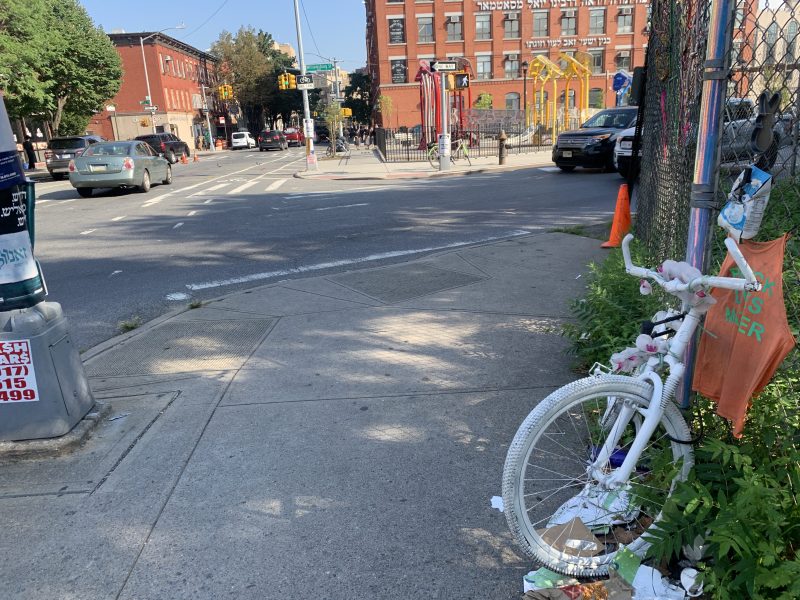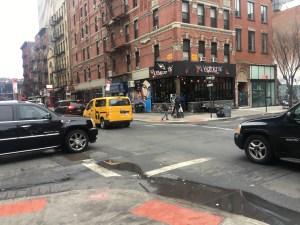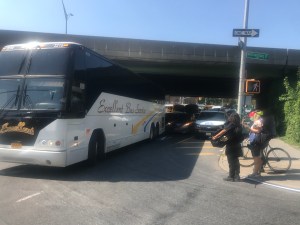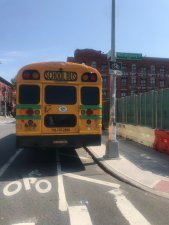REST IN PEACE, SARAH: Dangerous Williamsburg Intersection Gets Overdue Fix

The city will finally make safer a notoriously perilous Williamsburg intersection where 35-year-old cyclist Sarah Pitts was killed last September — one year after her death, and years after many cyclist and pedestrian injuries at that same spot could have been prevented, advocates said.
The dangerous stretch along Wythe Avenue — which is a crucial link between Williamsburg and neighborhoods to the south and east that has become a speedway for Brooklyn-Queens Expressway-bound drivers, as well as a bus parking zone for Hasidic schools — has long been a plague in the community, but complaints were largely ignored. Now, almost exactly one year after Pitts’s death, the Department of Transportation says it will physically separate cyclists from the moving cars, trucks and buses on Wythe between Williamsburg Street West and Penn Street.
It’s a move that Pitts’s family says should have come sooner.
“It shouldn’t take someone getting killed to keep the intersection safe,” Pitts’s brother, John, told Streetsblog. “That’s reactionary planning to a tragic event as opposed to really thinking bottom-up about making all streets safer for pedestrians and cyclists, and making that as high a priority as moving traffic through.”
On Sept. 7, 2020, about 30 minutes after midnight, police say that Pitts — a prosecutor in the Brooklyn District Attorney’s office who colleagues say dedicated her life to seeking justice — was fatally struck by a driver from the inaptly named Excellent Bus Service. Cops said that Pitts was traveling east on Wythe, where there are two lanes of traffic and a painted bike lane that’s routinely blocked by school buses in the largely Hasidic area, when she was hit by the massive charter bus, which was heading north on Williamsburg Street East, a key route to the BQE speedway.

Starting this week, DOT says it will install jersey barriers along Wythe Avenue between Williamsburg Street West and Penn Street — a stretch that includes the dark underpass of the Brooklyn-Queens Expressway and the corner where Pitts was killed. DOT says the work will wrap by the end of September.
Just days after Pitts’s death, Streetsblog reported that cops sat idling in their squad car as motorists parked in the bike lane and sped up to make the light through the same intersection — enraging friends of the victim who were across the street lighting candles and hanging flowers at a makeshift memorial.
Starting this month, NYC DOT will implement #BikeNYC safety improvements on Wythe Ave (Williamsburg St W to Penn St) in #Brooklyn. This work will:
????Improve safety
??Upgrade protected bike lanes
?Resurface the road
?Organize traffic pic.twitter.com/lhojqH5ooI— NYC DOT (@NYC_DOT) August 31, 2021
And since that day last year, there have been 29 crashes along just 418-feet of pavement between Williamsburg Street West and Penn Street, injuring two cyclists, three pedestrians and three motorists. Since 2017, three cyclists and 16 pedestrians have been injured in that same tiny zone, according to city stats viewable on Crashmapper.
And a look at the number of crashes on a larger portion of Wythe Avenue between Ross and Wallabout streets — which later turns into Franklin Avenue, and takes cyclists to Flushing Avenue — shows the scope of the problem. Since January, 2019, there have been 243 crashes, injuring nine cyclists and 20 pedestrians, according to Crash Mapper.
But some safe street advocates fear that the private buses and school buses that block the bike lanes with impunity, putting cyclists in danger, will persist without enforcement and adequate physical barriers design to prevent them.
“It might still be wide enough to drive a school bus into, if there’s no protection at the entrance,” said Philip Leff, the former chairman of Transportation Alternatives North Brooklyn Committee. “There should be a more substantial corridor throughout that neighborhood.”
DOT says it will “work with the relevant parties before and during the start of school,” to ensure the schools buses stay out of the bike lanes.

And as recently as January, it wasn’t clear whether the city would ever make that intersection safer. During a community board meeting, the long-overdue conversation about fixing the deadly intersection was again derailed when a longtime anti-bike lane crusader questioned the top Brooklyn police commander on the exact details of the crash, asking why the NYPD would make recommendations based on this one “accident.”
“We made recommendations based on this accident, but what exactly happened?” Simon Weiser, who co-chairs the transportation committee, asked at the time. “Let’s get the facts.”
And during that same meeting, a DOT staffer claimed at the time that the agency couldn’t install jersey barriers to protect cyclists unless someone, or some organization, volunteered to clean the bike lane themselves since the agency doesn’t have the proper equipment to do so.
“That’s not something we could do … without a partner who would be able to to clean the bike lane,” said Ronda Messer, who works in DOT’s Brooklyn office. “There’s not enough room to get a broom or a plow there, but this came up more than once and without a partner that’s able to consistently remove debris and snow, it’s not an option. We can’t put a barrier the way the design is now.”
Nearly nine months later, it seems DOT figured it out.
John Pitts says he’s grateful that he, along with his sister’s friends and family, were able to generate enough outcry to finally make a change there, but questioned what the means for those victims whose deaths don’t receive the same.
“If you’re only improving things when there’s outcry, people who didn’t get as much attention as Sarah did, are they improving those intersections?” he said. “That can’t be the way you make cyclist and pedestrian safety public policy. If you do it that way, it means all people who get attention are educated, higher-income, connected and use those tools of public pressure in ways that lower-income, minorities, and those that are not connected, can’t. It is not honest to who Sarah was to pretend that something that is focused on her is an actual solution.”



